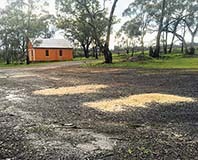Read the latest information on
Foot-and-mouth disease

Dumped grain can germinate and grow, providing a haven for pests of grains, ready to infest the nearest crops.
Most growers recognise that spilled grain on-farm is a biosecurity risk. Grain around storages, sheds, bunkers, bins and bags can attract and harbour grain storage pests that fly or hitchhike in from surrounding areas. Common pests include the lesser grain borer, flat grain beetle, rust-red flour beetle and warehouse moth.
“It is only a quick trip for insects from spills into the grain store itself, and before you know it your stored grain is spoiled by an infestation that will require time and money to remedy,” said Jim Moran, grains biosecurity officer in Agriculture Victoria.
“Other efforts to prevent infestation, such as coating the inside of empty grain storages and machinery used for sowing or harvesting with a desiccant dust, will also be for nothing,” added Mr Moran.
The same principles and outcomes apply to dumped grain, which also attracts and builds up populations of grain pests.
“The pests are then ready to move on to other nearby sources of food, such as stored grain.”
And it’s not just a risk for endemic pests. Should an exotic pest make it through Australian border controls, grain spills can harbour and build up its population too.
“Grain left to germinate will grow, disrupting local ecosystems and becoming an unmonitored host for a range of insects, fungi and other pests that affect crops. These can then invade local farms and threaten yields,” said Mr Moran.
Biosecurity only works if everyone along the grain supply chain uses good practices. For this reason, deliberate roadside spilling is against the Grain Transport Code of Practice established by Grain Trade Australia. Dumping is littering at best and a biosecurity risk to the entire grains industry at worst.
Mr Moran said that to help end this practice, growers can ask their grain freighters if they comply with the code of practice.
“Drivers delivering grain or any material that could pose a biosecurity risk must ensure that trailers are empty before leaving the delivery site.
“There should be no residual grain left in the trailer that then needs to be dumped prior to picking up a new delivery. If a truck turns up empty but not clean, it is possible residual grain has just been dumped.”
The code of practice stipulates the cleaning regime required after carrying particular products. After loads of untreated bulk grain, trucks should be blown out, swept or washed, so make sure your grain freighter is doing the right thing. Loads of grain infested with pests need to be washed with high-pressure water and sanitiser or steam.
“If there is grain left over that needs to be disposed of, do it safely. It can be burned, buried or bagged and reused, perhaps as livestock feed if it is uncontaminated.”
If you see dumped grain, report it to local government authorities or your state’s Environment Protection Authority. If you suspect a chemical is dumped with the grain, let your state agency know so that appropriate action can be taken.
Your state grains biosecurity officer can also have the matter further investigated.
Grain Transport Code of Practice
Acknowledgement: Reproduced from an article published in GRDC’s Ground Cover magazine